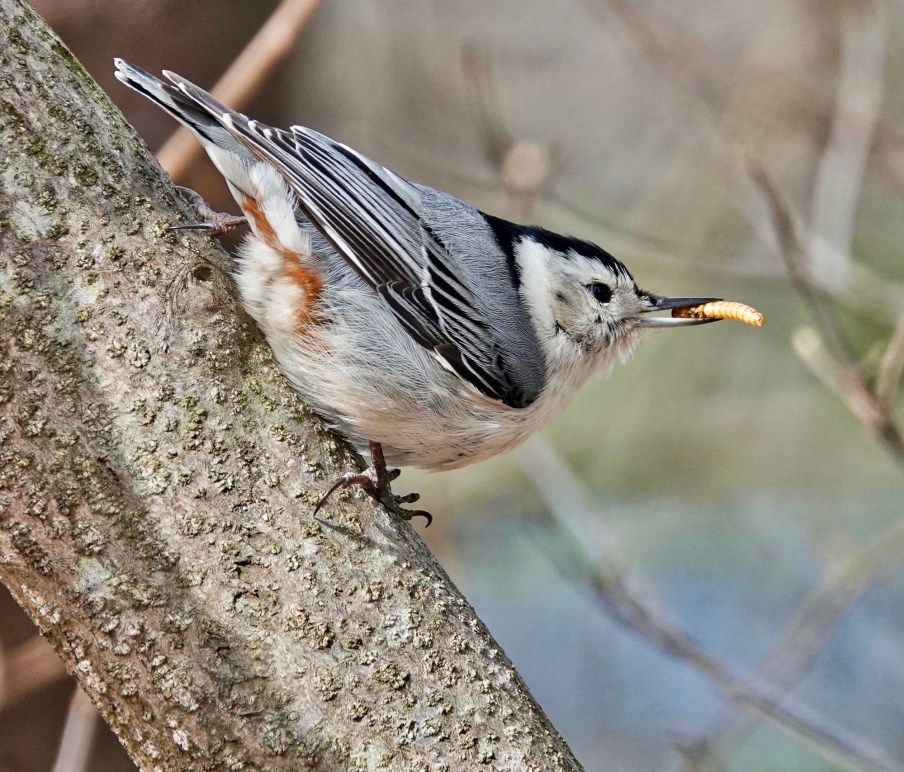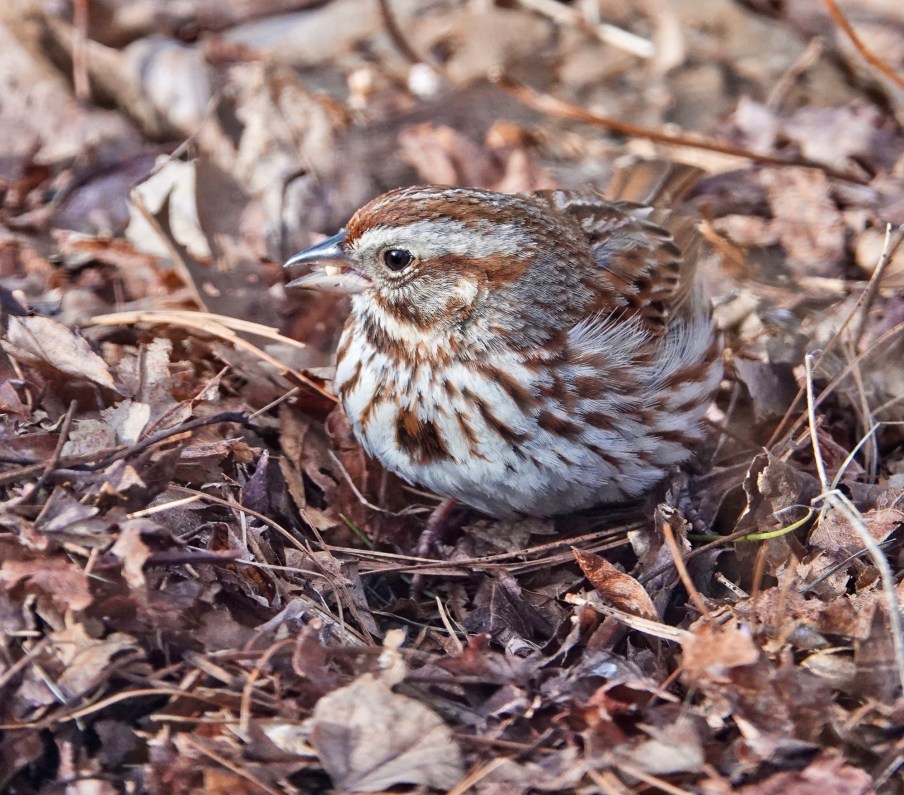Nuthatch with the prize

White-breasted Nuthatch, Kennebunk, Maine, USA.
We put the mealworms out, of course, for the bluebirds. We have had bluebirds frequenting our yard for the past 4 years. But (also of course) the other birds, Titmice, Chickadees, and Nuthatches also eat the mealworms. A mealworm is quite a mouthful for the smaller White-breasted Nuthatch. The Titmice and Chickadees only take the broken bits. A bluebird can swallow a mealworm whole. 🙂 This White-breasted Nuthatch took his prize up to a nearby branch to figure out how to deal with it. Sony Rx10iv at 600mm equivalent. Program mode with my custom birds and wildlife modifications. Processed in Polarr and Apple Photos.
Song Sparrow

Song Sparrow, Kennebunk, Maine, USA While Song Sparrows are common in the fields and even along the beach access road a few miles from home, we have seen very few in our yard…until this year, with the addition of the feeding station under the trees by my new photo blind. Now we have them daily, harvesting the spilled seed under the feeders. There is at least a pair, since I have seen them together. This one was about 8 feet from my blind where I had intentionally spilled some seed while filling the feeders. Sony Rx10iv at 600mm equivalent. Program mode with my custom birds and wildlife modifications. Processed in Polarr and Apple Photos.
Criminal intent…
The Grey Squirrels use my bird feeder setup near my photo blind as a jungle gym. All my feeders are, at least to the extent possible given modern technology, squirrel proof, and they have not yet solved the problems presented, so my seed is, for the moment, safe…but that does not stop them from trying. This squirrel is already, by the look of it, getting plenty to eat, so it can just leave my seed for the birds, thank you very much. Sony Rx10iv at 600mm equivalent. Program mode with my custom birds and wildlife modifications. Processed in Polarr and Apple Photos.
Pine Warbler, first warbler of spring

Pine Warbler, Kennebunk, Maine, USA There is a poem that goes with this. See below. First though it turns out I should not have been surprised that the first warbler of spring here in southern Maine was a Pine Warbler. According to the Audubon Guide to the Birds of North America online, the Pine Warner is singing on territory and nesting by April in Maine. This particular pine warbler was the first I have seen in our yard…but, again, according to Audubon, they are one of the few warblers that do come to feeders. You can see the seed I had scattered under the feeders by my blind around the bird’s feet. Sony Rx10iv at 600mm equivalent. Program mode with my custom birds and wildlife modifications. Processed in Polarr and Apple Photos.
And the poem:
4/20
Sitting in the blind on a chilly, cloudy
April afternoon, a bird flys in. At first
glance I am thinking female Goldfinch
since we have a lot of them around,
and it has that dull yellow color and
wing-bars…but then it hops down and
comes toward me through the leaf-
litter…not very Goldfinch like. I get
the camera on it and see the pale
streaking on the breast and that carpet
tack black bill. A warbler then, but
which one? Clearly not one of the
more obvious ones, or one I have
seen recently or often at all the past
or I would know it. The indexer in me
does that pinball machine thing where
it rolls down like the ball, bouncing off
the dull yellow Orange-crowned, and
the grayer Tennessee…the brighter
Palm and Prairie, looking for a home.
It comes to rest, just barely balanced
on Pine. But is it? It takes a visit to
iBird on my phone to convince me,
but, yes it is definitely a Pine. Isn’t it
wonderful how the birder’s mind works?
But I have to say, at first glance it still
looks enough like a female Goldfinch
so that I am not embarrassed at all.
Ma Cardinal in the rain

Northern Cardinal, Kennebunk, Maine, USA. We had a day of cold rain yesterday, and that made the feeders on the deck and by blind particularly active in the morning. By the time I got out there it had quieted down, but I did have a visit from this female Cardinal just before 11am. It was still raining and I was sitting on a damp chair in a leaky blind with my own and my camera’s rain jacket on. The things we do for a photo. This is a good example, technically, of how good the auto focus is on the Sony Rx10iv. 600mm equivalent. Program mode with my custom birds and wildlife modifications. Processed in Polarr and Apple Photos.
Looking up!

Eastern Bluebird, Kennebunk, Maine, USA. Things are looking up! At least this Eastern Bluebird is, and when the bluebird of happiness is looking up, well then, things can not be all that bad. 🙂 Just saying. Sony Rx10iv at 600mm equivalent. Program mode with my custom birds and wildlife modifications. Processed in Polarr and Apple Photos. Taken from my backyard photo blind.
Rumpled Nuthatch

White-breasted Nuthatch, Kennebunk, Maine, USA The White-breasted Nuthatch is such a sleek little bird that it is sometimes hard to get much feather detail at all in a photo. This one seems set to disprove the sleek assumptions. 🙂 One of the advantages of a photo blind is that, if you sit there long enough, you get to see all kinds of interesting behaviors. Sony Rx10iv at 600mm equivalent. Program mode with my custom birds and wildlife modifications. Processed in Polarr and Apple Photos.
The Cardinal came :)

Northern Cardinal, Kennebunk, Maine, USA There is a poem that goes with this.
Most days when I am out in the blind
waiting for birds to come fill my little
window, I hear the Cardinals calling.
There is one, a pair undoubtedly, that
lives down the street maybe six houses,
in a patch of wet woodland, and one
pair that lives on the loop of streets
behind us, in the little pine island
between our block and the next. At
least two pair then, in the neighborhood.
One evening after I had come in and we
were making supper I looked out and saw
a male Cardinal at the the feeders by
my blind…and I have waited, not all that
patiently, every day since for it to come
while I was there to see it. Kind of hoping
against hope since I have only ever
seen maybe three in our yard in the
25 years we have lived here. But today,
the male came. It wanted to drink from
the hanging bird bath, and worked it’s
way through the vines around it two
or three times without figuring out how
to do it. But oh the poses and the
postures and that red crest flaring,
and that big deep rose pearl of a beak
in the black mask and the little black pearl
of an eye…and the light was just right,
and I am satisfied, full on Cardinal, and
yes I am confident it won’t be long before
he figures out how to get to the bird bath,
and then, maybe he will bring his mate,
and then his brood when they fledge, and
we will have the red of Cardinals in our yard
most days. Wouldn’t that be something!
Sony Rx10iv at 600mm equivalent. Program mode with my custom birds and wildlife modifications. Processed in Polarr and Apple Photos.
Bluebird at the feeder

Eastern Bluebird, Kennebunk, Maine, USA. I am, of course, getting lots of “bird-at-the-feeder” shots from my new photo blind. For the most part, unless it is a really rare bird, or a bird that I am unlikely to get a “better” shot of (better being perched naturally away from the feeder), you will never see my bird-at-the-feeder shots. However, sometimes there is a shot at the feeder that, to my eye, has enough redeeming value to be part of my published work 🙂 Like this one. Great flat light. Bird doing something interesting in an interesting pose, etc. Bluebirds love mealworms, and we put out dried mealworms, which we buy 5 pounds at time on-line, particularly to attract them. This is one of my new feeders, one of the few that I have found that will actually dispense mealworms reliably, and is at least somewhat squirrel proof. (If a squirrel attempts to hang off the perch to feed the whole outer shell slides down on a spring and closes the feeder port.) We also have a cup like feeder on our back deck but we only put out a few mealworms at a time there so the squirrels do not get in the habit of raiding it. (I have our squirrels pretty much “deck-trained” after years of effort…but that is a whole other story.) On an interesting technical note, I have had to create a processing preset in Polarr specifically for Bluebirds. The blue is just too blue, and if you add any “vibrancy” at all, you lose a lot of the feather detail. Sony Rx10iv at 600mm equivalent. Program mode with my custom birds and wildlife modifications. Processed in Polarr and Apple Photos.
Chickadee beauty shot

Black-capped Chickadee, Kennebunk, Maine, USA. You don’t actually need a blind to photograph chickadees up close. They will come to my feeders while I am actually out among them adding seed. The blind does give me the opportunity to observe them going about their business without being aware of me, and I am, of course, getting a lot of shots of chickadees in all manner of poses and settings. I like this shot for its aesthetic appeal. It is something about the way the berry shoots segment the frame, the touch of red from the out of focus berries themselves, and naturally neutral grey background…and, of course, the bird itself in all its native perkiness. The tack-sharp feather detail and the quality of the light helps too. All in all, to my eye, it is a beauty shot. Sony Rx10iv at 600mm equivalent. Program mode with my custom birds and wildlife modifications. Processed in Polarr and Apple Photos.







